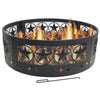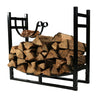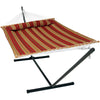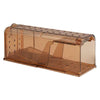There’s no way around it…
… fresh-cut firewood is never going to burn the way you want.
Firewood that you recently split or cut usually features a moisture content around 100%, which means half the weight of the wood is from water.
As you can imagine or may have experienced, wet wood doesn’t burn. That means firewood needs to be seasoned and properly dry before using it.
Whether you use firewood to heat your home for the fall and winter months or you want to enjoy a backyard bonfire, the quality of your firewood is crucial.
On top of that, burning unseasoned firewood in a stove or fireplace that is used to heat your house can lead to creosote build-up in your chimney, which can cause a dangerous chimney fire or smoke build-up in the house.
Seasoned firewood is not only easier to ignite, but it is much lighter to carry, produces a cleaner burn, and is safer overall.
So, how do you season firewood to ensure it is ready to keep you warm and cozy in the winter months? After reading this article, you will be an expert at preparing firewood so it is properly seasoned and aged.
First, let’s take a look at what seasoned firewood looks like so you know when your wood is ready.
How to Tell if Firewood is Seasoned
There are many different factors to look at when analyzing if your firewood is dry and ready for burning.
Here some properties of firewood that is seasoned and ready to use:
- Weight
Dry wood is much lighter compared to green wood, or freshly cut firewood. As you season wood it loses its moisture level, and the difference in weight will be very noticeable, especially if its softwood.
- Color
Green wood is more bright and colorful than seasoned wood. As the firewood becomes drier over time, the color will fade until it is more of a dull, gray color.

- Bark
Another property of seasoned wood is the ease of removing the bark. The bark on dry wood is loose, while the bark on green wood is difficult to separate.
- Cracks
The presence of cracks in firewood is another good indicator that it is seasoned and ready to use.
However, be aware that not all seasoned firewood cracks, so make sure to evaluate the other properties of dry wood mentioned as well.
- Strength
Green wood is easier to split and dent compared to seasoned wood. As wood drys, it becomes more compressed than freshly cut wood.
- Smell
Green wood has a distinct, sappy smell that is easy to notice. Dry wood, however, does not have such a powerful scent and has more of a classic woodsy smell.
- Moisture Level
As discussed earlier, freshly cut wood is extremely high in moisture content. For wood to be considered seasoned, it must have a moisture content below 20%, ideally around 10%.
We recommend using a moisture meter to accurately measure how seasoned your firewood is. You can typically find a moisture meter in your local hardware store if you don’t already have one.
- Sound
The last property of seasoned firewood we’ll discuss is the sound it makes when struck against another piece of wood.
Dry wood will make a hollow sound, while wet wood will make a dull thud when the two pieces strike each other.
Now that we know how to tell when firewood is seasoned, let’s get into the tips and strategies to make your firewood dry quickly.

6 Tips to Season Firewood Quickly
1. Know the What Type of Wood You’re Using
The type of wood you use matters.
Although you may not have options when it comes to what type of wood you want to seasons, some firewood is better than others.
Also, the type of wood you’re using will determine how long you need to season it. For example, pine and other types of softwoods may only need 6 months to properly season, while hardwoods like oak require at least a year.
To find out more about the different types of wood, which is best, and how long each takes to season, check out our article on the best firewood types for your fireplace.
2. Prepare During the Right Time of Year
Gathering and preparing firewood to be seasoned is best during the summer months when the sun is most present and the temperature is warmer.
Also, make sure to time out the seasoning process based on your wood type. For example, if your firewood takes 6 months to season and you want it ready by October, then start preparing during early spring.
3. Cut, Split, & Size Your Wood Correctly
When you chop your wood to prepare it for seasoning, you want to ensure the pieces are all similar in size. This allows you to better stack your wood later.
We recommend cutting to the standard face cord size, which is 16 inches long. This way it will fit better in smaller stoves and can easily stack on smaller firewood log racks.
After cutting it, you’ll want to split it into a manageable shape and size. The most common and effective way people split wood is into quarters.
Also, never use wood from a dead or dying tree because the wood will not burn properly.

4. Keep It Outdoors
The best place to season your firewood is outside in the sunlight. Firewood that is placed indoors will not season properly and there is always the risk of termites entering your home.
If you live in a rainy area, open-air storage like a barn or shed is another option, but ensure that the wood gets quality airflow.
5. Correctly Stack the Wood
Stacking your firewood the correct way is essential to seasoning your firewood quickly.
When stacking your firewood, ensure that it is elevated so no wood is touching the ground. Pieces that are touching the ground will remain wet and cause fires that are uneven.
Choose a good stacking area that gets plenty of sunlight and is away from any structures. You want to make sure the wood you are stacking gets plenty of airflow.
An easy and effective way to stack wood for seasoning is to use a firewood log rack, which will keep the wood off the ground and let both ends get plenty of air and sunlight.

6. Properly Cover Your Firewood
The last tip is to keep your firewood protected with a cover. This will make rain or snow run off your stack without soaking the wood.
Any rainfall that falls on your wood replaces the sap as the water evaporates, causing your firewood to burn faster and become less efficient.
Make sure you leave the ends of the stack uncovered, however, to allow maximum air to circulate and moisture to escape.
Stay Warm This Winter & Enjoy Warm Backyard Fires
Seasoning your firewood is vital to have a warm, clean, and safe fire that’ll last all evening.
Obtaining a stack of dry firewood takes time, but by using these tips you start to see faster and more effective results.
Before burning your firewood in a stove, fireplace, or outdoor fire pit, ensure that your wood is properly seasoned to stay extra warm this winter or to make your backyard fire last all night.
As always, feel free to comment with any questions or with your firewood seasoning experiences below, and if you found this article helpful remember to share.





























































10 comments
Steve
Correction – Dead wood burns fantastically as often nature has pre-seasoned it for you; of course if it is very rotten then it is very often less good or no good at all. A dose of common sense is all that is needed. I had some really nice and very hot fires from dead tree wood without any issues and no need to wait for it to dry as that already done by virtue of it being dead!
Alan Dean
Cover the wood with transparent plastic and you will season the wood faster from the heat that will build up!
Nick Gidzak
if you need the firewood NOW!
start off with a acouple 2×4 to start the fire, and green wet wood will burn once the fire is going… the head from the stove will suck out the moisture from the wood in the room. so tomrrows fire will be easier to light.
If you need the firewood in a week. i found that putting the wood in a spare bedroom (if you ahve one) with a fan and a dehumidifyer makes short work of the moisture level of the wood. you can pull out about 4L of water every 8 hours it will be dried in a week.
Me487976
Don’t burn dead trees? So, burn living trees only? What a strange piece of misinformation!
Eulah Brennan
Dear sunnydazedecor.com administrator, Your posts are always on point.
Katherine Roberts
I’ve burned the already down “dead” trees. As long as you get a recently down dying tree they’ll season and burn fine because they won’t be punky.
India Posey
Hello sunnydazedecor.com owner, Thanks for the well-structured and well-presented post!
Keith
I burn wood from dead trees all the time. BTUs are BTUs. Most of the time its very dry. I don’t understand your comment on that. I’ve burning in wood stoves for years. No issues. BUT I only burn hardwood.
Maurice Winfrey
Hello sunnydazedecor.com admin, Nice post!
tim
how long to season oak maple cherry poplar mulberry woods locus